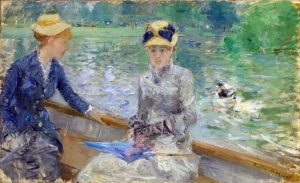Berthe Morisot

Berthe Morisot (1841-1895) was a key figure in the Impressionist circle. Born into a comfortable Paris family, she and her sister took up painting seriously in the late 1850s. The sisters studied independently with minor but supportive and knowledgeable artists. When they gravitated toward landscape in the early 1860s. they sought out Jean-Baptiste-Camille Corot, who, struck by the quality of their work, met with them repeatedly, even giving them one of his paintings to study.
As a woman, Morisot could not go the Café Guerbois (gathering place for artists), but nonetheless she became an intimate of and even a favorite within the avant-garde circle, socializing with Manet, Degas, and other Realists. She especially developed a close friendship with Manet, posing for him in seven paintings. Morisot’s brushwork became looser and her palette brighter. Her figures are generally women and children, the models most readily available to her.
Undoubtedly, what impressed Morisot’s vanguard colleagues was her brilliant technique and finesse: her bold brushwork magically defined figures and objects while creating an abstract tapestry of paint across the surface of the canvas, a deft balancing act that even Manet had to admire.

We can see her painterly brilliance in Summer’s Day (The lake in the Bois de Boulogne), a classic Realist/Impressionist theme of a leisure activity taking place at a trendy venue. Typical of Morisot, the fashionably dressed figures do not interact, but instead are deep in thought. While the palette is closer to Manet than to Monet, the scene is a summer day with light flickering off of objects. Morisot enhances the spontaneity created with her brush marks by using an asymmetrical, cropped composition, first developed by Degas.
Mary Cassatt

Like Morisot, Mary Cassatt (1844-1926) approached Impressionism from a woman’s perspective. Cassatt was an American, born into a wealthy family and raised in Pittsburgh. She trained at the Pennsylvania Academy of Art in Philadelphia, where her family moved, in part to support her career as an artist, a most unusual attitude for the time. In 1866, she went to Paris and studied with an artist who offered classes for women, before being accepted as a student of the renowned academic Jean-Léon Gérôme. In Paris, she befriended Degas and abandoned her academic style for Realism. Invited by Degas, she participated in the fourth Impressionist exhibition in 1879.
Scholars often attribute Cassatt’s subject matter to the restrictions she faced as a female: As a respectable woman, she could not go unattended to the same places as her male counterparts. But more at issue was her belief in the importance of women in society, even if this importance was largely restricted to the home.

Cassatt painted many domestic scenes of mothers tending their children, such as The Child’s Bath. The pitcher and basin may seem quaint and old-fashioned to us today (only America had wide-spread indoor plumbing at this point), but regular bathing was a modern phenomenon for late nineteenth-century Paris, when people generally bathed only once a week. Not only is the picture about health, but also about intense emotional and physical involvement, as is reflected in the tender manner with which the caregiver touches the child.
The picture contains all the ingredients we associate with Realism – the fashionable bourgeois décor, the bright colors, and the sense of spontaneity in the brushwork and skewed composition with its high viewpoint. The style of the picture reflects Cassatt’s intense attraction to Japanese prints at this point in her career, an interest that is reflected in the overhead viewpoint as well as in the boldness of her forms and contours. Cassatt was also influenced by Renaissance art. Many of Cassatt’s presentations of a mother and child resemble Renaissance depictions of a Madonna and Child, and allusion that sanctifies the important role of women in creating a better society.[1]
- Penelope J.E. Davies, et. al. Janson’s History of Art: The Western Tradition, (Upper Saddle River, NJ: Pearson, 2007), 878-880 ↵

